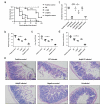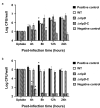The lipoprotein NlpD in Cronobacter sakazakii responds to acid stress and regulates macrophage resistance and virulence by maintaining membrane integrity
- PMID: 33459158
- PMCID: PMC7834084
- DOI: 10.1080/21505594.2020.1870336
The lipoprotein NlpD in Cronobacter sakazakii responds to acid stress and regulates macrophage resistance and virulence by maintaining membrane integrity
Abstract
Cronobacter sakazakii, an emerging opportunistic pathogen, is implicated in severe foodborne outbreak infections in premature and full-term infants. Generally, acid tolerance is vital for the pathogenesis of foodborne pathogens; however, its role in C. sakazakii virulence remains largely unknown. To screen out acid-tolerance determinants from transposon mutants, anovel counterselection method using gentamicin and acid was developed. Using the counterselection method and growth assay, we screened several acid-sensitive mutants and found that nlpD encodes an acid-resistance factor in C. sakazakii. Compared to the wild-type strain, the nlpD mutant exhibited attenuated virulence in a rat model. Using macrophage THP-1 cells and a pH probe, we verified that nlpD enables bacteria to resist macrophages by resisting acidification. Finally, we confirmed that nlpD maintains C. sakazakii membrane integrity in acid using propidium iodide permeabilization assays via flow cytometry. Our results confirm that nlpD is a novel virulence factor that permits C. sakazakii to survive under acid stress conditions. Considering that NlpD is a conserved lipoprotein located in the bacterial outer membrane, NlpD could be used as a target for drug development.
Keywords: Cronobacter sakazakii; acid resistance; lipoprotein; membrane integrity.
Conflict of interest statement
The authors have no competing interests to disclose.
Figures







Similar articles
-
NlpD as a crucial factor in desiccation resistance and biofilm formation in Cronobacter sakazakii.Sci Rep. 2025 Feb 21;15(1):6289. doi: 10.1038/s41598-025-90905-4. Sci Rep. 2025. PMID: 39984582 Free PMC article.
-
Analysis on pathogenic and virulent characteristics of the Cronobacter sakazakii strain BAA-894 by whole genome sequencing and its demonstration in basic biology science.Microb Pathog. 2017 Aug;109:280-286. doi: 10.1016/j.micpath.2017.05.030. Epub 2017 May 22. Microb Pathog. 2017. PMID: 28546117
-
Identification of potential virulence factors of Cronobacter sakazakii isolates by comparative proteomic analysis.Int J Food Microbiol. 2016 Jan 18;217:182-8. doi: 10.1016/j.ijfoodmicro.2015.08.025. Epub 2015 Sep 5. Int J Food Microbiol. 2016. PMID: 26546912
-
Insights into virulence factors determining the pathogenicity of Cronobacter sakazakii.Virulence. 2015;6(5):433-40. doi: 10.1080/21505594.2015.1036217. Epub 2015 May 7. Virulence. 2015. PMID: 25950947 Free PMC article. Review.
-
Cronobacter sakazakii: stress survival and virulence potential in an opportunistic foodborne pathogen.Gut Microbes. 2014;5(6):711-8. doi: 10.4161/19490976.2014.983774. Gut Microbes. 2014. PMID: 25562731 Free PMC article. Review.
Cited by
-
Impact of Human Body Temperature on Stress Tolerance and Transcriptome of Cronobacter sakazakii.Pathogens. 2025 Mar 14;14(3):281. doi: 10.3390/pathogens14030281. Pathogens. 2025. PMID: 40137766 Free PMC article.
-
Effects of ESA_00986 Gene on Adhesion/Invasion and Virulence of Cronobacter sakazakii and Its Molecular Mechanism.Foods. 2023 Jun 30;12(13):2572. doi: 10.3390/foods12132572. Foods. 2023. PMID: 37444309 Free PMC article.
-
Identification and Evaluation of Novel Antigen Candidates against Salmonella Pullorum Infection Using Reverse Vaccinology.Vaccines (Basel). 2023 Apr 18;11(4):865. doi: 10.3390/vaccines11040865. Vaccines (Basel). 2023. PMID: 37112777 Free PMC article.
-
Design of a multi-epitope vaccine against Haemophilus parasuis based on pan-genome and immunoinformatics approaches.Front Vet Sci. 2022 Dec 29;9:1053198. doi: 10.3389/fvets.2022.1053198. eCollection 2022. Front Vet Sci. 2022. PMID: 36644533 Free PMC article.
-
Proteomic Analysis Revealed Metabolic Inhibition and Elongation Factor Tu Deamidation by p-Coumaric Acid in Cronobacter sakazakii.Front Microbiol. 2022 May 9;13:888103. doi: 10.3389/fmicb.2022.888103. eCollection 2022. Front Microbiol. 2022. PMID: 35615519 Free PMC article.
References
-
- Elkhawaga AA, Hetta HF, Osman NS, et al. Emergence of Cronobacter sakazakii in cases of neonatal sepsis in Upper Egypt first report in North Africa. BMC Microbiol. 2020;11:215. .Epub 2019/12/29. 10.3389/fmicb.2020.00215. PubMed PMID: 32210926; PubMed Central PMCID: PMCPmc6935241 Pmc7075355. - PMC - PubMed
-
- Guo D, Wang S, Li J, et al. The antimicrobial activity of coenzyme Q(0) against planktonic and biofilm forms of Cronobacter sakazakii. Food Microbiol. 2020;86:103337. .Epub 2019/11/11. PubMed PMID: 31703870. - PubMed
-
- Chen Z, Zhang Y, Lin R, et al. Cronobacter sakazakii induces necrotizing enterocolitis by regulating NLRP3 inflammasome expression via TLR4. J Med Microbiol. 2020;69(5):748–758. .Epub 2020/03/27. PubMed PMID: 32209170. - PubMed
-
- Control CfD, Prevention . Enterobacter sakazakii infections associated with the use of powdered infant formula–tennessee, 2001. MMWR Morb Mortal Wkly Rep. 2002;51(14):297. - PubMed
-
- Wang M, Wang L, Wu P, et al. Genomics and experimental analysis reveal a novel factor contributing to the virulence of cronobacter sakazakii strains associated with neonate infection. J Infect Dis. 2019;220(2):306–315. .Epub 2019/03/06. PubMed PMID: 30835279. - PubMed
Publication types
MeSH terms
Substances
LinkOut - more resources
Full Text Sources
Other Literature Sources
